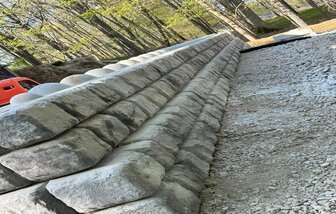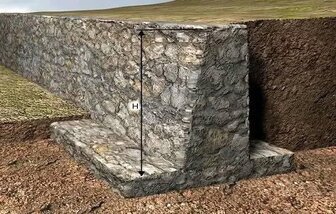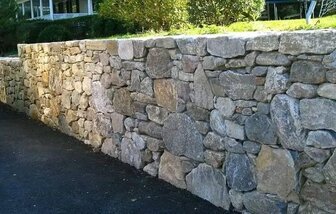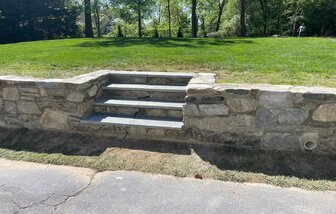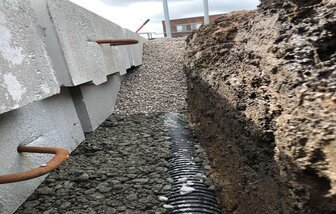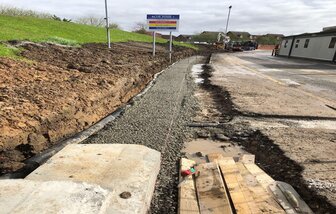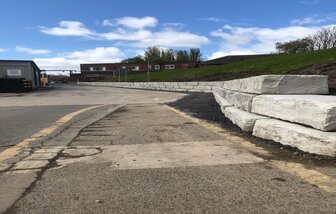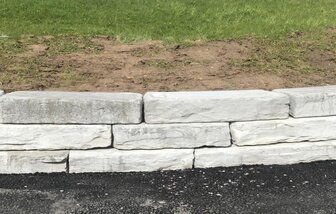How to build a Retaining Wall
Learn about retaining walls and their essential role in landscape design, offering both functional and aesthetic benefits. Discover various types of retaining walls, suitable materials, and important planning and design considerations to ensure stability and sustainability. Explore practical tips for site preparation, construction, and drainage to create durable and visually appealing retaining walls for your garden or outdoor space in the UK.
How to Build a Retaining Wall: A Comprehensive Guide for the UK
Retaining walls are essential structures in landscape design, providing both functional and aesthetic benefits. These walls serve the primary purpose of holding back soil and preventing erosion, particularly in areas where the terrain is uneven.
By creating level areas in a sloped garden, retaining walls can transform unusable spaces into functional zones for various outdoor activities. Additionally, they enhance the aesthetic appeal of gardens and outdoor areas by adding structure and visual interest.
In essence, a retaining wall is a specially engineered structure designed to resist the lateral pressure of soil. This is particularly important in regions prone to heavy rainfall, where the risk of soil erosion is significant.
By stabilising the earth, retaining walls contribute to the longevity and sustainability of landscape designs. Beyond their practical applications, these walls can be designed to complement and enhance the overall appearance of the landscape, making them a versatile addition to any outdoor space.
There are various types of retaining walls, each suited to different applications and environments. Gravity walls, for instance, rely on their own weight to hold back soil and are often constructed from heavy materials such as stone or concrete.
Cantilever walls, on the other hand, use a reinforced concrete base that extends into the earth, providing additional stability. Sheet piling walls are used in tighter spaces and involve driving thin steel, wood, or vinyl sheets into the ground. Finally, anchored walls are supported by cables or other stays anchored in the rock or soil behind the wall, offering a robust solution for taller structures.
Choosing the right type of retaining wall depends on various factors, including soil type, slope gradient, and the intended use of the space. Whether the goal is to create a terraced garden, a functional patio area, or a visually appealing landscape feature, understanding the basics of retaining walls is the first step in making informed decisions for your outdoor project.
Retaining walls not only prevent soil erosion but also add a touch of elegance and practicality to any garden or landscape design in the UK.
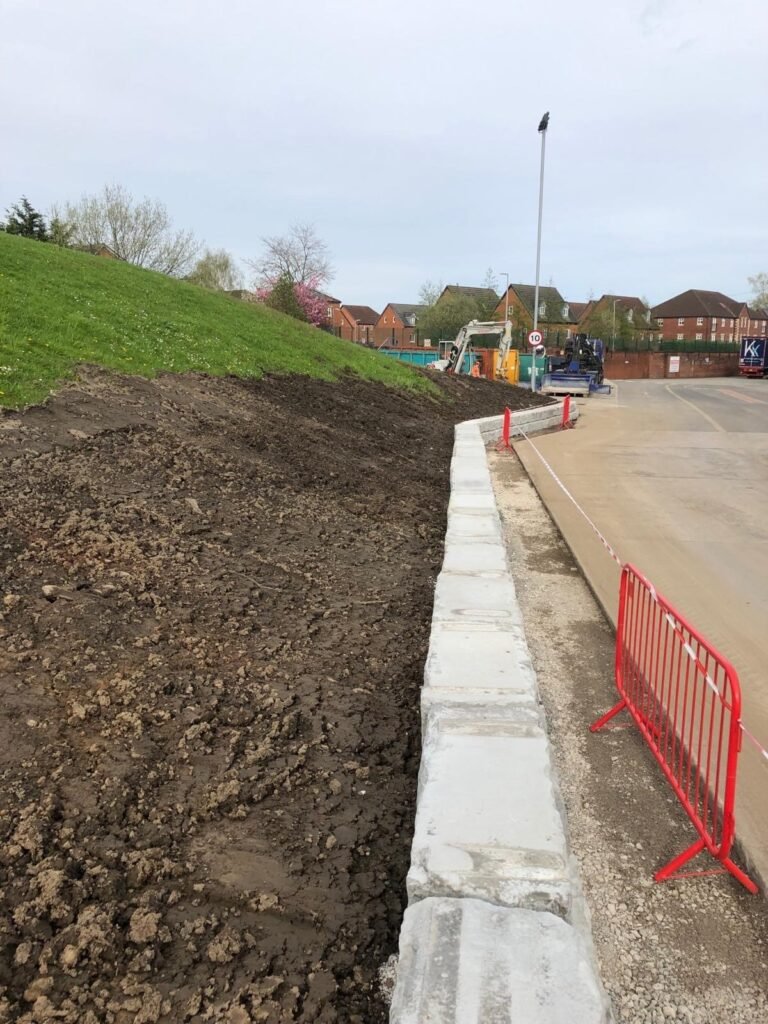
Before embarking on the construction of a retaining wall, meticulous planning and design considerations are paramount. The first step involves assessing the site where the wall will be constructed. This includes examining the topography, soil type, and drainage patterns. The type of soil is a critical factor as it influences the stability and structural requirements of the wall. For instance, clay soils may require more robust construction techniques compared to sandy or gravelly soils.
Understanding local building regulations in the UK is another crucial aspect. Each local authority may have specific guidelines regarding the construction of retaining walls, particularly those exceeding a certain height. It is advisable to consult with the local planning office to ensure compliance with all relevant regulations and to obtain any necessary permits.
The purpose and design of the retaining wall should also be clearly defined. Are you aiming to prevent soil erosion, create a terrace for gardening, or enhance the aesthetic appeal of your property? The intended purpose will influence the height and length of the wall, as well as the choice of materials. Common materials include concrete blocks, natural stone, and timber, each offering different benefits and aesthetic qualities.
Drainage requirements must not be overlooked during the planning phase. Proper drainage is essential to prevent water accumulation behind the wall, which can exert pressure and compromise its integrity. Incorporating weep holes, drainage pipes, and backfill materials can facilitate effective water management.
Creating a detailed plan is indispensable, particularly for larger projects. This includes drafting precise measurements, selecting suitable materials, and outlining the construction steps. For complex or sizeable retaining walls, consulting with a professional engineer is highly recommended. An engineer can provide expert advice on structural integrity, load-bearing capacity, and safety considerations, ensuring the longevity and reliability of the wall.
In summary, thorough planning and design considerations are crucial for the successful construction of a retaining wall. By assessing the site, understanding local regulations, defining the wall’s purpose, and addressing drainage requirements, you can lay a solid foundation for your project.
When embarking on a project to build a retaining wall, the choice of materials is a pivotal decision that will impact the durability, cost, appearance, and ease of installation. Various materials are commonly used, each with its own advantages and disadvantages. This section examines concrete blocks, natural stone, brick, timber, and gabion baskets to help you make an informed decision.
Concrete blocks are a popular choice due to their strength and versatility. They are available in various shapes and sizes, allowing for flexibility in design. Concrete blocks are relatively easy to install, especially when interlocking types are used, which can reduce the need for mortar. However, they can be more expensive than some other options and may require additional finishing for aesthetic purposes.
Natural stone offers a timeless and aesthetically pleasing option. Stones like granite, limestone, and sandstone can create a natural look that blends seamlessly with the landscape. Natural stone is highly durable and can withstand harsh weather conditions, but it can be costly and labor-intensive to install. Precision is needed to fit the stones together securely, often requiring professional expertise.
Brick is another durable material that provides a classic appearance. It is relatively easy to work with and can be laid in various patterns to enhance visual appeal. Brick walls typically require mortar, adding to the installation time and cost. While brick is long-lasting, it may not be suitable for very tall walls unless reinforced.
Timber is a cost-effective and aesthetically pleasing option, often used for smaller retaining walls. It is relatively easy to install, and treated timber can resist weathering and decay. However, timber may not be as durable as other materials and could require more maintenance over time to prevent rotting and insect damage.
Gabion baskets are wire cages filled with rocks or other materials. They are highly durable and effective for erosion control. Gabion walls have a distinctive, rugged appearance and can be constructed relatively quickly. However, they might not be suitable for all aesthetic preferences and can be more expensive if high-quality rock fill is used.
When selecting a material for your retaining wall, consider the specific needs of your project, including the desired appearance, budget, and required durability. Consulting with a professional can also provide valuable insights and help ensure that you choose the right material for your retaining wall.
Before initiating the construction of a retaining wall, meticulous site preparation is crucial to ensure the stability and longevity of the structure. The first step in this process involves marking out the wall’s location. Utilize stakes and a string line to outline the desired position, ensuring the layout is straight and aligned with your design plans. This preliminary step sets a clear guideline for excavation and subsequent construction activities.
Once the location is marked, proceed with excavating the area. Depending on the wall’s height and design, the depth of the excavation will vary. Typically, a trench should be dug to a depth of at least 150mm to 200mm below the planned base of the wall. This depth allows for the inclusion of a solid foundation material such as crushed stone or gravel. Ensuring a level base is essential; a laser level or a spirit level can be employed to achieve this precision, which is vital for the wall’s structural integrity.
Proper drainage is another critical aspect to address during site preparation. Without adequate drainage, water accumulation behind the wall can increase pressure and compromise its stability. Incorporate a drainage system, such as a perforated pipe wrapped in a geotextile fabric, at the base of the wall. This setup will facilitate the efficient removal of water, thereby mitigating potential issues related to hydrostatic pressure.
Soil compaction is equally important. Compact the soil at the bottom of the trench to create a firm foundation for the retaining wall. Use a hand tamper or a mechanical compactor to achieve the desired level of compaction. This step helps prevent future settling and movement, which could otherwise lead to structural failures.
During site preparation, employing the correct tools and adhering to safety precautions cannot be overstressed. Essential tools include a shovel, wheelbarrow, laser level, and compactor. Additionally, ensure to wear appropriate personal protective equipment (PPE) such as gloves, safety goggles, and sturdy footwear to safeguard against potential hazards.
By following these steps, you can lay a strong and stable foundation for your retaining wall, setting the stage for a successful construction project.
The foundation of a retaining wall is crucial for its longevity and stability. A robust foundation ensures that the wall can withstand the pressure exerted by the soil and any additional loads. Whether you are constructing a retaining wall with blocks, stones, or other materials, starting with a solid foundation is imperative.
Begin by excavating a trench at least twice the width of the blocks or stones you plan to use, and make sure the trench is deep enough to accommodate the first course. For most retaining walls, a depth of about 150mm to 300mm is sufficient, but this can vary based on the wall’s height and the soil type. It is essential to dig below the frost line to prevent frost heave in colder climates.
Once the trench is prepared, add a layer of compacted gravel or crushed stone, about 75mm to 150mm thick, to create a stable base. This layer helps with drainage and minimizes the risk of the wall shifting over time. Compact the gravel thoroughly using a tamper or plate compactor to ensure it is firm and level.
Next, lay the first course of blocks or stones directly on the compacted base. This initial layer is the most critical, as it sets the tone for the entire wall. Use a spirit level to check that each block or stone is level, both front-to-back and side-to-side. Adjust as necessary by adding or removing gravel underneath. Regularly checking for levelness throughout this process can prevent future alignment issues.
After laying the first course, backfill behind the blocks with free-draining material such as gravel or crushed stone. This step is essential for preventing water buildup behind the wall, which can lead to pressure that may cause the wall to fail. Proper backfilling also helps in maintaining the wall’s stability.
For different types of retaining walls, the foundation techniques may vary slightly. For example, timber retaining walls require anchoring posts set in concrete, while concrete block walls might need a reinforced concrete footing. Regardless of the material, ensuring a level and well-compacted foundation is the key to a durable retaining wall.
Constructing a retaining wall involves meticulous attention to detail to ensure its stability and longevity. Begin by laying the foundation. Excavate a trench to the depth specified in your design plan, which typically includes a base layer of compacted gravel to provide solid ground support. This base is crucial for preventing shifting and settling over time.
Once the base is prepared, start stacking the materials. If you are using interlocking blocks, ensure that the first row is perfectly level and aligned. Interlocking blocks are designed to fit together seamlessly, providing added strength and stability. Use a rubber mallet to gently tap blocks into place, ensuring they are snugly fitted without gaps.
For mortared stone walls, mix the mortar according to the manufacturer’s instructions. Spread a layer of mortar on the base and set the first row of stones into the mortar bed. Use a spirit level to check alignment and make adjustments as needed. Each subsequent row should be staggered, similar to laying bricks, to enhance the wall’s structural integrity. Apply mortar between stones and remove any excess with a trowel.
Reinforcement may be necessary for higher retaining walls. Geogrid reinforcement can be integrated between rows of blocks or stones to provide additional stability. This material helps distribute the weight and pressure exerted on the wall, reducing the risk of bulging or collapse.
Throughout the construction process, continuously check that the wall is level and aligned. Any deviation can compromise the wall’s effectiveness and durability. Use a long level or string line to keep the top of the wall straight and true.
Follow the planned design rigorously, ensuring that drainage considerations, such as weep holes or drainage pipes, are incorporated as specified. Proper drainage is essential to prevent water buildup behind the wall, which can cause hydrostatic pressure and potential failure.
By adhering to these construction principles, you will create a robust and reliable retaining wall that enhances both the aesthetic appeal and functional landscape of your property.
When constructing a retaining wall, ensuring proper drainage is crucial to prevent water buildup behind the structure. Accumulated water can exert excessive pressure on the wall, potentially leading to structural failure. Implementing effective drainage solutions, such as weep holes, perforated pipes, and gravel backfill, is essential for maintaining the wall’s integrity over time.
One common drainage method is the installation of weep holes. These are small openings placed at regular intervals along the base of the wall, allowing water to escape. To install weep holes, drill holes at the bottom of the wall, ensuring they are spaced about 1-1.5 meters apart. Line the holes with a filter fabric to prevent soil from clogging them, thus ensuring a clear pathway for water to drain.
Another effective solution is the use of perforated pipes. These pipes, typically made of plastic, are laid horizontally at the base of the wall within a trench. The pipes should be placed on a slight gradient to facilitate water flow towards a designated drainage outlet. Cover the pipes with a layer of gravel to improve filtration and prevent soil from entering the system. This method is particularly effective for larger walls where significant water accumulation is likely.
Gravel backfill is an additional measure that enhances drainage. After constructing the retaining wall, fill the space immediately behind it with gravel. This material allows water to percolate through while preventing soil erosion. For optimal results, use gravel with a mix of different particle sizes to ensure stability and effective drainage. The gravel layer should be at least 30 centimeters thick and extend from the base to the top of the wall.
To ensure long-term effectiveness of these drainage solutions, regular maintenance is essential. Periodically check weep holes and perforated pipes for blockages, and clear any debris that may hinder water flow. By implementing and maintaining proper drainage systems, you can significantly enhance the lifespan and stability of your retaining wall, ensuring it remains a robust structure for years to come.
Building a retaining wall is only part of the process; completing the project with the right finishing touches and maintaining it over time are equally critical. To start, capping the retaining wall not only enhances its visual appeal but also protects it from weathering. There are various capping options available, including concrete, stone, and decorative pavers. Choose a material that complements the wall and surrounding landscape, ensuring the capstones are securely fixed with appropriate adhesive.
Landscaping around the retaining wall further integrates it into the environment, transforming a functional structure into a feature that enhances your outdoor space. Planting shrubs, flowers, or even installing a small garden bed at the base of the wall can soften its appearance. Consider using plants that thrive in the UK climate, ensuring they are appropriate for the wall’s exposure to sunlight and moisture levels. Mulching the area around the plants can help retain soil moisture and suppress weeds.
Adding aesthetic features can also make your retaining wall stand out. For instance, incorporating lighting fixtures along the wall can create an inviting ambiance in the evening. Water features, such as small fountains or cascading water, can add a tranquil element to the landscape. These additions not only beautify the area but also increase the wall’s functionality and enjoyment.
To ensure the longevity of your retaining wall, regular maintenance is essential. Inspect the wall periodically for any signs of wear, such as cracks or bulging. Small cracks can be repaired with masonry sealant, but more significant structural issues may require professional intervention. Proper drainage is crucial to prevent water pressure build-up behind the wall, which can lead to failure. Ensure that any weep holes or drainage pipes are clear of debris and functioning correctly.
If you notice any leaning or shifting of the wall, it is vital to address these issues promptly. Minor adjustments can be managed by regrading the soil or adding additional support. However, for major concerns, consulting with a professional is advisable to prevent further damage. Regularly check the integrity of the wall’s foundation, as a stable base is imperative for the wall’s overall stability.
By paying attention to these finishing touches and adhering to a diligent maintenance routine, your retaining wall will remain a sturdy and attractive feature of your landscape for years to come.
What is a Retaining Wall?
Discover the essential aspects of retaining walls in landscape architecture. This comprehensive guide covers the types of retaining walls, materials used, and key design considerations. Learn about the construction process, regulations, and maintenance tips to ensure stability and longevity.
Types of Retaining Walls
Discover the importance of retaining walls in the UK, used to stabilise sloped terrain, prevent soil erosion, and manage water runoff. Learn about different types including gravity, cantilever, sheet piling, anchored, gabion, and reinforced soil retaining walls, and understand their applications, materials, advantages.
What is the purpose of Retaining Walls?
Discover the importance of retaining walls in landscaping and structural engineering. Learn about different types of retaining walls such as gravity walls, cantilever walls, sheet piling walls, and anchored walls.
Garden Retaining wall
Discover the essential role garden retaining walls play in landscaping, from erosion control to aesthetic enhancement. Learn about the benefits, popular materials, and design ideas to transform sloped gardens into functional and beautiful outdoor spaces.
Building Retaining Walls
Learn about retaining walls and their essential role in landscape design, offering both functional and aesthetic benefits. Discover various types of retaining walls, suitable materials, and important planning and design considerations to ensure stability and sustainability.
Foundation Depths For Retaining Walls
Discover the importance of retaining walls in landscaping and structural engineering. Learn about different types of retaining walls such as gravity walls, cantilever walls, sheet piling walls, and anchored walls. Follow a step-by-step guide
How to maintain Retaining Walls
Learn all about retaining walls, their importance in preventing soil erosion, and their applications in both residential and commercial settings in the UK. Discover the different types of retaining walls, how to inspect and maintain them, and the best practices
Retaining Wall Building Materials
Learn about different types of retaining walls and their applications, including concrete blocks, poured concrete, natural stone, brick, timber, and gabion baskets. Understand their benefits, limitations, and how to choose the right material for your project to ensure both functionality and aesthetic appeal.
Ready to start your project?
Let's Work Together
To get started, for general enquiries simply complete the form below. Provide us with your project details, and our team will review your requirements. We will then get back to you with a customised solution that fits your needs. Whether you have a small-scale project or a large-scale development, we have the expertise and resources to handle it. Once we have received your submission, you will receive a confirmation email (Please check all your email boxes)
If you prefer, and have a project in mind and seeking a price you can also send us your project documents and any photographs directly to admin@totalgroundworks.co.uk We will carefully examine your documents and provide you with a competitive quote together with a timescale from inception through to completion for your project.

